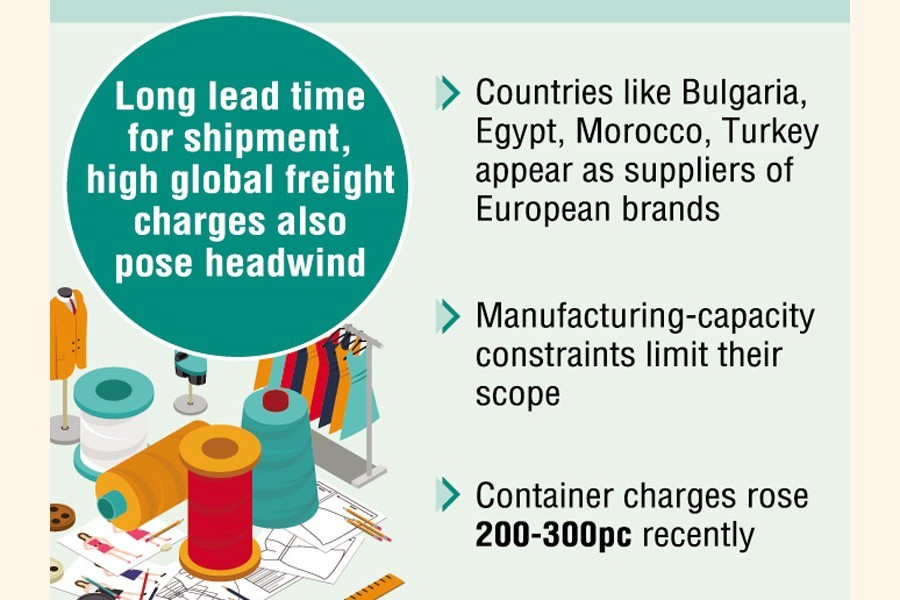Global buyers' pandemic-induced strategy shift to import apparel from nearest countries worries Bangladeshi exporters as they consider the 'near-shoring' stance a future threat for the industry.
Industry leaders opine that Bangladesh can't fully grab the recent opportunity mainly because of near-shoring which buyers are opting for due to long lead-time the country incurs in shipping goods as well as global high freight charges.
The pandemic has shed a light on the vulnerability of global supply chains and there is a lack of preparedness by the offshore outsourcing industry, they said, adding that long lead-time and high freight charges have pushed many of the global buyers to develop their sourcing from nearby though it adds additional costs to them.
A recent International Labour Organization (ILO) brief also hinted near-shoring as the re-emergence of garment production closer to major markets in Europe and North America.
Quoting evidence, the brief also said that European Union buyers and the European Commission are looking to facilitate greater near-shoring through reductions in garment-related trade duties in countries like Bulgaria, Egypt, Morocco and Turkey, all of which already supply European brands.
However, near-shoring prospects could be overstated because such a trend may ultimately be limited by manufacturing-capacity constraints in many of these countries, it also observed.
Another McKinsey survey of 60 senior supply-chain executives in 2020 found 93 per cent of them planning to increase the level of resilience across their supply chains with a greater focus on near-shoring, dual-sourcing or regionalising supply chains an integral part of that strategy.
Italian clothing group United Colors of Benetton recently said, according to media reports, it is to grow its production focus on Turkey, Croatia, Tunisia and Egypt with the aim of halving production in Asia from the end of 2022 mainly to have more control over the production process and also transport costs.
Sweden's furniture giant IKEA is also planning to move more production to Turkey to minimise problems with global supply chains and increased shipping costs.
When asked, Faruque Hassan, president of Bangladesh Garment Manufacturers and Exporters Association (BGMEA), said: "Though our exports have started reviving with the improved global Covid-19 situation, new challenges have also surfaced."
Due to the disruption to global freight management, container charges have gone up by 200 to 300 per cent in recent times, he said, adding such high freight charges have pushed global buyers towards near-shoring.
"Near-shoring, the practice of transferring a business operation to a nearby country, especially in preference to a more distant one, has emerged as a new challenge for us," he said, explaining that buyers are now developing their business in Turkey, Bulgaria, Morocco and some other East European countries mainly to shorten lead time and save freight cost.
Echoing his views, Mohammad Hatem, executive president of Bangladesh Knitwear Manufacturers and Exporters Association (BKMEA), told the FE that though capacity of those countries are not as high as Bangladesh, it might be enhanced within next five years if buyers continue to source from them.
"Decades back, Bangladesh also did not have the capacity which it now has. It's the buyers' demand to set up thousands of garment factories here," he noted.
Shahidullah Azim, vice-president of BGMEA, Monday said exporters should not be complacent over the flooded work orders placing in the country as he cautioned that orders are now shifting to other countries like Turkey and Morocco mainly due to the lengthy lead-time here in Bangladesh.
A recent study titled 'An Empirical Study on Leadtime of Readymade Garments in Bangladesh' by National Institute of Textile Engineering and Research (NITER) says Bangladesh has been in a disadvantageous situation among the RMG-supplying countries due to higher lead-time constraint.
The competitive advantages earned by cheaper production cost are being nullified by higher lead times.
Depending on foreign sources for raw materials is dragging the industries behind. Citing data, it says just for fabrics 30-40 days are being added to the production lead-time.
In the 90's lead-time was 120- 150 days which now got reduced to 90 to 100 days, it said, adding that China can deliver products within 30 to 35 days while lead time for Vietnam is 60 days.
The study identified inefficiency in planning, traditional production system, weak transportation network, lack of deep-sea harbour, inadequate port facility and labour unrest as factors responsible for Bangladesh's longer lead time.
Talking to the FE, Fazlee Shamim Ehsan, another BKMEA leader, however, opined that near-shoring is not a major challenge for Bangladesh due to their limited capacity.
He also said that Bangladesh cannot grab the full benefits of orders shifting from China due to its electricity crisis and trade war with the US and factory closure in Vietnam for Covid.
He stressed measures so that Bangladesh can reduce its lead time by 10 to 15 days, which, according to him, is possible by efficient handling of customs and ports and developing deep-sea port.


